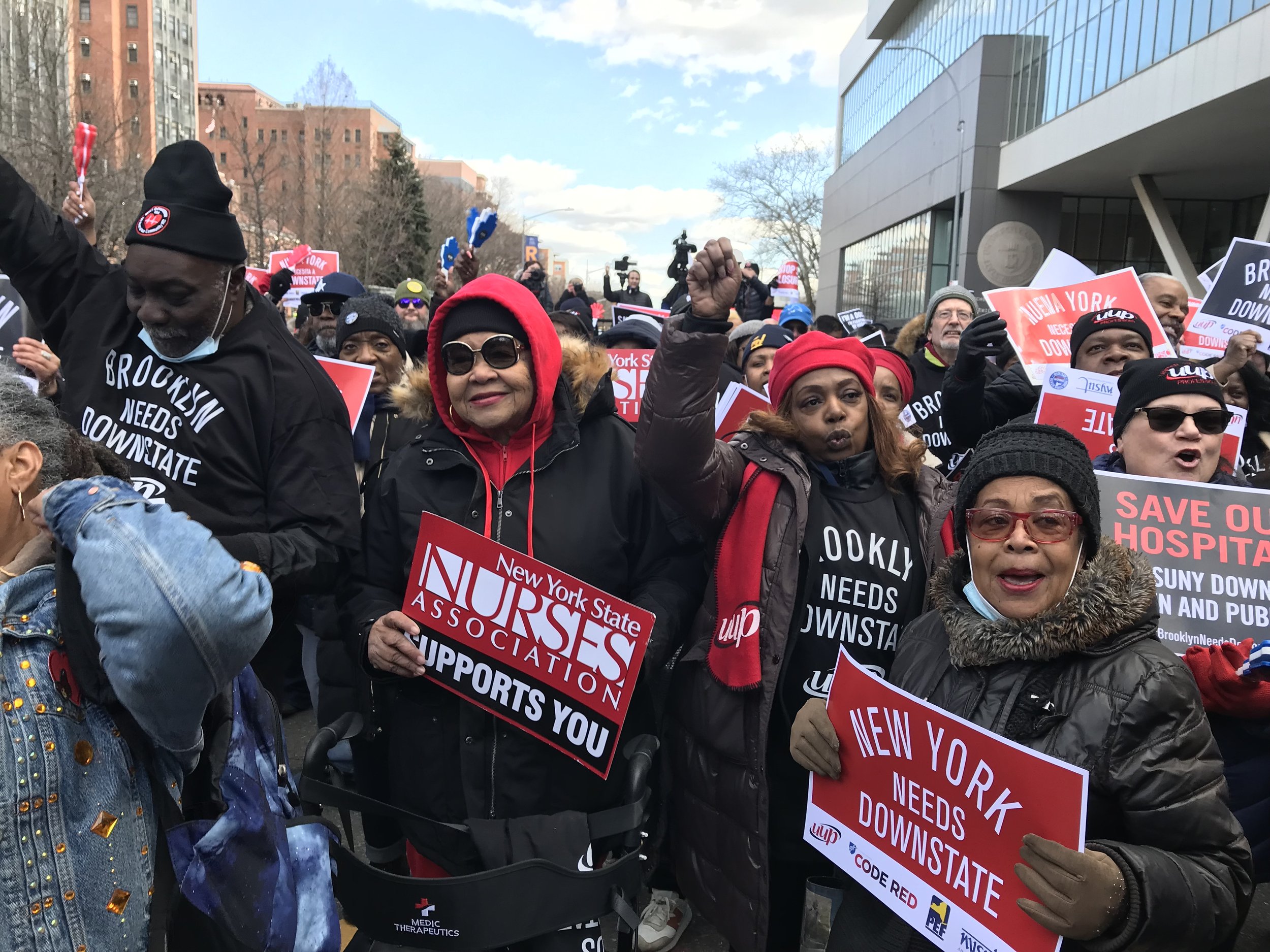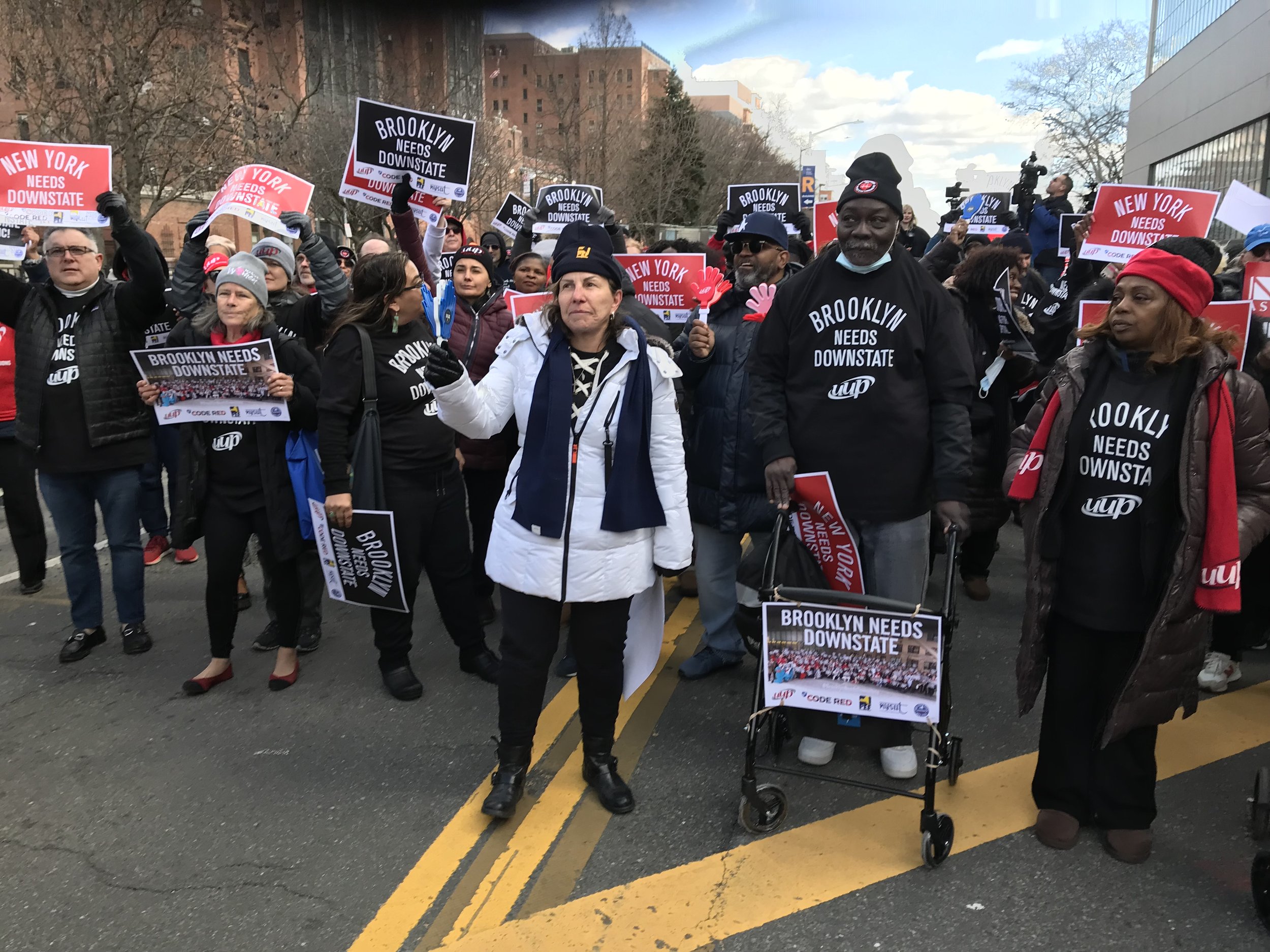Hochul ‘Locking Out Black Mothers and Black Babies!’ in Brooklyn
Members of the New York State Nurses Association denounce the closure of SUNY Downstate University at a rally held outside the venerable facility this week. Photos/Steve Wishnia.
By Steve Wishnia
“We’re here for one reason. Brooklyn needs Downstate,” United University Professions leader Frederick E. Kowal told a rally of several hundred people outside the hospital Feb. 29. Many in the crowd protesting the state’s plan to close the East Flatbush facility carried signs or wore T-shirts with the same slogan, in the white-on-black team colors and font of the Brooklyn Nets.
Gov. Kathy Hochul, Kowal said, talks about “how horrified she is about the maternal-mortality rate in the African-American community,” but by closing the hospital, she would be “locking out black mothers and black babies.”
The State University of New York’s Downstate University Hospital boasts that it has trained more New York City physicians than any other medical school. It has the only kidney-transplant unit in Brooklyn and is also the borough’s designated regional perinatal center, for dealing with high-risk pregnancies and births. UUP represents about 2,300 workers there, basically all the medical staff except for nurses.
SUNY’s plan to “transform” Downstate, announced Jan. 16 and included in Hochul’s proposed budget, would close the 342-bed hospital, replacing it with 150 beds in a wing of Kings County Hospital across the street. It would spend $300 million to keep the medical school open, expand outpatient care, and create a “a cutting-edge Brooklyn Institute of Health Equity to tackle the systemic health disparities the communities we serve face on a daily basis.”
SUNY argues that the change is necessary to save Downstate, because it’s losing $100 million a year; the hospital is underutilized, with less than half the beds full on average; that the trend in medicine is toward more outpatient care; and the building has deteriorated to the point where it would cost too much to renovate or rebuild it. It says it expects to preserve “approximately 80% to 90%” of the UUP jobs there, and all jobs for the three smaller unions, such as the Public Employees Federation.
Protesting pushing back against the closure of SUNY Downstate University Hospital fill the street outside the facility on Feb. 29.
Critics say it doesn’t make sense to shrink a hospital in a community that desperately needs health care. Downstate gets a bigger share of its revenue from Medicaid than any hospital in New York State, according to UUP.
State Sen. Zellnor Myrie (D-Brooklyn) cited a state Department of Health study released Feb. 1 that said the lowest proportions of doctors and hospital beds, residents who have health insurance, and doctors who accept Medicaid “are found in zip codes with a large proportion of Hispanic and Black populations in eastern Brooklyn.”
“We suffer from hypertension, diabetes, heart disease, and kidney disease,” he told the crowd. “And our solution is to close you down?”
“This is an injustice,” said New York State Nurses Association President Nancy Hagans, noting that central Brooklyn has among the lowest hospital-bed capacities in the city. “New York needs to invest in health care, not shut it down.”
“Kings County won’t be able to take care of the overlap of patients,” says Michelle D., a nurse who did not want to give her last name. “They already have a long wait time. For both the emergency room and the clinic.”
Assemblymember Latrice Walker (D-Brooklyn) told Work-Bites after the rally that closing the hospital was “ludicrous and stupid. This is a jewel of our community.”
The plan would also affect medical education, says Jogy Mathew, director of academic information technology. “The reason why students come to Downstate is so they can practice and do their residency in the same place.”
“Brooklyn Needs Downstate” sign displayed in neighborhood shop.
Critics of the state plan also say it was developed and released without listening to area residents. “There was no community input,” Walker says.
“It’s unacceptable that we found out by chance,” Assemblymember Monique Chandler (D-Brooklyn)—who gave birth to her first child at Downstate—told the crowd, saying she didn’t hear about the plan until a constituent called her about it.
‘Justify our existence’
The rally filled the street in front of the Downstate building, a 1950s beige-brick structure with a newer rectangular box grafted onto its front, and the 1930s red brick of Kings County. It combined loud Brooklyn-in-the-house pride with a spirited church-service flavor. After Myrie compared protesters standing in the hair-above-freezing cold to Shadrach, Meshach, and Abednego being cast into the fire—a story the crowd knew well enough to shout the names—speakers vied for Biblical allusions. The Rev. Al Sharpton said Brooklyn needs a Good Samaritan, not someone who’ll pass by the wounded man and say they “didn’t have the budget” to stop, while the Rev. Liz Theoharis of the Poor People’s Campaign said Jesus “didn’t charge the leper a copay.”
Rabbi Eli Cohen said Brooklyn hospitals need “not a Band-Aid, but a transfusion.” Kings County and Methodist Hospital in Park Slope are overcrowded, he added. But Kingsbrook and Interfaith aren’t, because they’re closed.
Both those hospitals served the East Flatbush-Crown Heights area. Downstate survived then-governor Andrew Cuomo’s attempt to privatize it in 2013.
“In COVID we stepped up to the challenge and saved lives,” said PEF President Wayne Spence. “We should not have to justify our existence.”
“I owe my family to the work they did at Downstate,” Peter Kinoy of Brooklyn told Work-Bites. The hospital saved his wife and son’s lives, he explained, when the baby was born prematurely in 1984 and spent four weeks in the neonatal intensive-care unit.
Kowal told Work-Bites after the rally that the state plan would cause a “tremendous loss of jobs” at the hospital, and would have a “devastating” effect on care, according to staff and local residents.
“The Legislature should not accept the language in the budget,” he says. “It’s extortion. It’s blackmail. The governor says, ‘you’ll only get the money if you agree to this transformation.’”
He called it “ironic” that the plan includes an institute to study health-care disparities, when it would close a major hospital in a predominantly Afro-American and Afro-Caribbean area.
“No shutting down, no shutting down,” says Lystra Bovell, 64, who lives near the hospital and has been a patient there for years. “They save a lot of lives. Bottom line, a very good hospital.”
Tapping her metal cane on the pavement for emphasis, she added, “Downstate is not going nowhere.”



